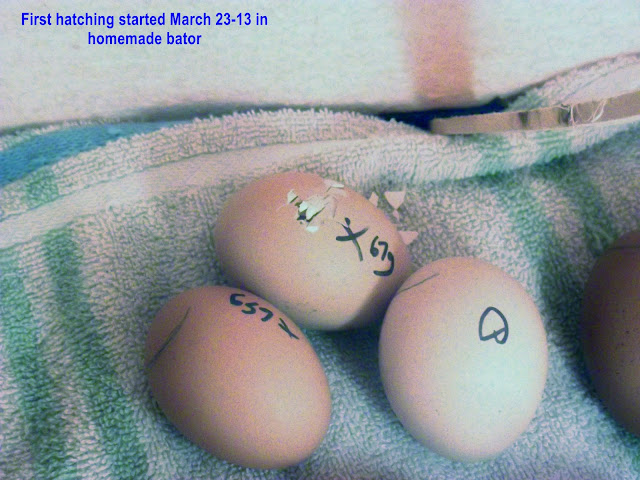Since hatching our own chicks from eggs, which is considerably more involved - an incubator, water to create humidity, a light bulb burning day and night, a thermometer that measures humidity and temperature, marking each egg, constant monitoring of humidity and temp., daily turning of the eggs {twice a day}for about 18 days. Then for the last few days the humidity has to go up considerably while still turning them. After 21 days for chickens, your straining to hear a pip or two, informing you that you did everything right and a baby chick is alive inside the egg and is about to hatch. No an easy task for the poor little creatures. If your lucky, the chick can hack its way out on its own. If not, you may have to assist. We learned a lot.
 | ||||||
| Eggs cannot be cold, at room temperature and marked before going into a pre-warmed bator. |
 | |
| Into the home-made incubator with water, light and monitor to be turned twice a day. |
 |
| We bought a used, smaller incubator later on after we got more eggs to hatch. Notice Winston keeping watch on the chair. |
 |
| This is how many eggs fit into the smaller incubator. Marking them helps to tell which way you've already turned them. |
 | |
| Its called a 'pip' when you can hear a live chick chirp inside its egg. 67 grams here, was the first successful hatching we had on March 23rd of this year. |
 |
| 67 grams is hammering away at its egg and wanting OUT! |
 |
| Look Close and you'll see a newly hatching chick inside the bator. |
 |
| A successfully hatched, live chick that is healthy and well-formed. |
Catspaw



That is quite the process. But Oh, what a cute little chickie!
ReplyDeleteIsn't it though. it is very involved but the result is worth all the work.
ReplyDelete